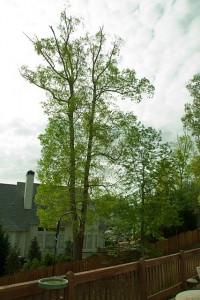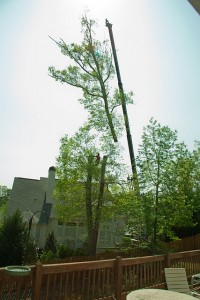
This last Friday we were hit with some pretty good thunderstorms. The highlight of my Friday night was sitting at the kitchen table with my family, just about to serve up some ice cream when a lightning strike touched down right outside the house – specifically, hitting our neighbor’s ~80 foot tall oak tree about 40 yards away from where I was sitting. To the left is the tree in question – a marvel of nature’s longevity
On this night I learned a few important things.
- Always have spare clean underwear available – your family may need it.
- Lightning can make a big electrical-type bang when it’s real close. The thunder afterwards is just a bonus.
- White men can jump.
- My oven can scream. Really. It’s the only word for it. Ironically, it seems fine, but had the audacity to display “PF” on the display (Power Failure). Far from a lack of power, I would say.
I also learned that apparently when a tree is hit with lightning, the surge of electricity down the trunk makes the moisture inside the tree boil away extremely quickly, and the net results is that it literally blows the bark off the tree (see Exhibit A, below):

This damage extends pretty much right up the tree – the bits of bark were blown all over my deck and some even made it over the roof of my house and into the front yard. Impressive stuff! Sadly for this beautiful(-ish) tree, it turns out that the lightning also destroyed half the root ball. Big tree with half the root ball missing == extremely dangerous. And so on Tuesday this week:

Yes, there is an insane guy half way up the bit of the tree still attached to the ground. I’ve not seen a tree being removed quite so efficiently before. In the space of about 90 minutes, we went from big tree to no tree. I hear a whale crying somewhere.
While my neighbor counts the cost of that removal (you just know that their insurance carrier isn’t paying a dime towards that work), I’ve been counting the cost of the storm indoors. All things considered, things aren’t too bad (that we’ve discovered so far), and appear to amount to:
- Dead thermostat on basement HVAC (which turned out to be dead batteries… hahaha)
- HDMI input on my big screen TV no longer has sound. Weird.
- The Wii now has very poor wireless access – almost like its antenna got blown away or something. The actual console works fine, but since my youngest likes to watch Netflix on the Wii, the constant (and I really mean constant) buffering is a bit fail-worthy. Other devices (PS3, Roku) are streamning just fine.
- My Juniper Netscreen SSG5 wireless firewall (acting as my WAN router/firewall at home) is unhappy.
Ok, let me cycle back on the last one for a moment, since I’m allegedly a geek. On the night of the strike, we lost Internet access. Once I’d calmed the children down as they realized that they couldn’t have Netflix until it was fixed, I started looking into the problem. The port my cable modem is plugged into (ethernet0/1) was down. Annoying. The cable modem looked good based on the lights, so I tried moving it to another port on the SSG5 – result, it came up on ethernet0/0. Some more testing confirmed that ethernet0/1 is indeed toast. Ok, so a few minutes to reconfigure ethernet0/0 to be my WAN interface instead and we’re back up. Comcast then kindly – for reasons they couldn’t explain – put me in the walled garden, meaning I couldn’t get out anywhere. 15 minutes later we had that taken care of, and the world was ours once more. So far so good.
Then I remembered about my IPv6 tunnel – and another 10 minutes was spent reconfiguring that with my provider to point to the (inevitable) new WAN IP I had picked up, and to move the configuration over to join the WAN config on ethernet0/0. 15 minutes later the config changes on both ends had completed and I was back on the IPv6 Internet (hooray).
I probably spent 45 minutes or so in total troubleshooting and repairing my Internet connectivity, and mourning the loss of an ethernet port. Today, I was looking in the event log, and noted this repeated periodically (remember to read bottom up – most recent events are at the top):
2011-04-20 22:14:32 system notif 00513 The physical state of interface
ethernet0/2 has changed to Down.
2011-04-20 22:14:32 system notif 00612 Switch event: the status of ethernet
port ethernet0/2 changed to link down,
duplex half, speed 10M.
2011-04-20 22:14:32 system notif 00513 The physical state of interface
ethernet0/2 has changed to Up.
2011-04-20 22:14:32 system notif 00612 Switch event: the status of ethernet
port ethernet0/2 changed to link up,
duplex half, speed 100M.
Son of a gun…I have a flapping port! Wait, that sounds bad. Let’s try “the router has a flapping port” instead. It’s odd, because I hadn’t noticed any intermittent connectivity on anything, but this was like a rash in the event log. How could I possibly have missed this?
It turns out that there is actually nothing connected to ethernet0/2. If anybody can give me a great reason why a port might do this under normal circumstances, I’m all ears. Otherwise, I’m chalking up ethernet0/2 to the lightning monster as well. And god help me, I’d better double check all the other ports too; there are only 8 ports on this firewall, so I’m already 25% down and unamused… hopefully my insurance wants to buy me a new one. :/
Now, I’m not saying that the ice cream was directly related to the lightning strike, but perhaps I should avoid ice cream for a while. Or start eating it only while seated in the car. Given fryguy’s twitter diet challenge, it probably all works out for the best in the end 🙂




Leave a Reply